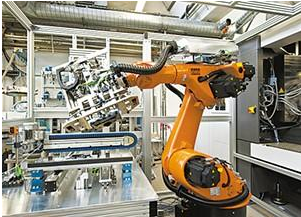The "robot revolution" is known as the entry point and important growth point of the "third industrial revolution", which will affect the global manufacturing landscape. In order to seize the international commanding heights of the new generation of industrial robots, the robot industry development plan jointly issued by the Ministry of Industry and Information Technology, the National Development and Reform Commission, and the Ministry of Finance proposes to provide better development opportunities for my country's robot industry, enhance the independent innovation capabilities of enterprises, and make breakthroughs in new materials, new perceptions, and intelligence. Control and other cutting-edge technologies and key technologies to speed up the technological research and development and prototype production of a new generation of industrial robots.

The replacement effect of industrial robots is obvious, and the market advantage is constantly showing. It is understood that based on the 10-year service life depreciation, the annual cost of industrial robot products is about 50,000 yuan, and the annual cost of 3 mature welding technicians needs at least 216,000 yuan. When an industrial robot produces the same benefits, the input cost is 23% of the labor cost. This ratio will greatly reduce the manufacturing cost of the enterprise, provide a broad space for the profitability of the enterprise, and increase the price competitive advantage of the enterprise.
However, the use density of industrial robots in my country is far below the global average, and the gap is even more pronounced compared with developed countries such as South Korea, Japan, and Germany. For example, South Korea is the country with the highest density of industrial robots in the world, with 396 robots per 10,000 people; Japan has 339 units per 10,000 people; Germany ranks third with 267 units per 10,000 people. The number of industrial robots owned by 10,000 people in my country is only 23, which is less than half of the international average of 58. At present, the proportion of industrial robots in my country is 6.4%, Japan is 26.6%, the United States is 13.8%, Germany is 13.6%, and South Korea is 10.8%. From this point of view, the huge gap with developed countries means that my country's industrial robot market has great potential for development.
With the continuous improvement of the intelligent level of industrial robots, my country's industrial robots have been applied in many fields. The "Production and Sales Demand Forecast and Transformation and Upgrading Analysis Report of China's Industrial Robot Industry" released by the Foresight Industry Research Institute shows that industrial robots have been widely used in automobile and auto parts manufacturing, electronic and electrical industries, rubber and plastics industry, food industry and other fields. in. In my country, about 33% of industrial robots are used in automobile manufacturing and auto parts manufacturing industries, and about 31% of industrial robots are used in electrical and electronic industries.
As of 2017, the production of industrial robots in my country has exceeded 130,000 sets, a cumulative increase of 68.1%, of which 12,682 sets were produced in December, a year-on-year increase of 56.5% in a single month, continuously occupying the largest market for industrial robots. 2018 to 2020 will be the most important three years for the development of China's industrial robot industry, which will directly affect the achievement of the robot industry's development plan. As domestic and international brands have expanded their production, the newly started factories will achieve mass production in 2018 and 2019. In the next three years, the output of domestic industrial robots will double on the current basis. By 2020, the output of domestic industrial robots may exceed 250,000 units. Behind the rapid increase in output has also driven the demand for talents in the robotics industry. Whether it is robot maintenance, debugging, operation or programming, a large number of relevant technical personnel are required. Now that there are serious job vacancies in industrial robots, it is a good time to enter the industrial robot industry.
Easy Electronic Technology Co.,Ltd , https://www.yxpcelectronicgroups.com